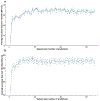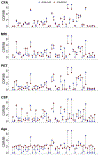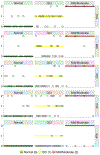A practical computerized decision support system for predicting the severity of Alzheimer's disease of an individual
- PMID: 31402810
- PMCID: PMC6688646
- DOI: 10.1016/j.eswa.2019.04.022
A practical computerized decision support system for predicting the severity of Alzheimer's disease of an individual
Abstract
Computerized clinical decision support systems can help to provide objective, standardized, and timely dementia diagnosis. However, current computerized systems are mainly based on group analysis, discrete classification of disease stages, or expensive and not readily accessible biomarkers, while current clinical practice relies relatively heavily on cognitive and functional assessments (CFA). In this study, we developed a computational framework using a suite of machine learning tools for identifying key markers in predicting the severity of Alzheimer's disease (AD) from a large set of biological and clinical measures. Six machine learning approaches, namely Kernel Ridge Regression (KRR), Support Vector Regression, and k-Nearest Neighbor for regression and Support Vector Machine (SVM), Random Forest, and k-Nearest Neighbor for classification, were used for the development of predictive models. We demonstrated high predictive power of CFA. Predictive performance of models incorporating CFA was shown to consistently have higher accuracy than those based solely on biomarker modalities. We found that KRR and SVM were the best performing regression and classification methods respectively. The optimal SVM performance was observed for a set of four CFA test scores (FAQ, ADAS13, MoCA, MMSE) with multi-class classification accuracy of 83.0%, 95%CI = (72.1%, 93.8%) while the best performance of the KRR model was reported with combined CFA and MRI neuroimaging data, i.e., R 2 = 0.874, 95%CI = (0.827, 0.922). Given the high predictive power of CFA and their widespread use in clinical practice, we then designed a data-driven and self-adaptive computerized clinical decision support system (CDSS) prototype for evaluating the severity of AD of an individual on a continuous spectrum. The system implemented an automated computational approach for data pre-processing, modelling, and validation and used exclusively the scores of selected cognitive measures as data entries. Taken together, we have developed an objective and practical CDSS to aid AD diagnosis.
Keywords: Alzheimer’s disease; cognitive impairment; decision support system; dementia; diagnosis support; machine learning.
Conflict of interest statement
Declarations of interest None
Figures






Similar articles
-
Ensemble Model for Diagnostic Classification of Alzheimer's Disease Based on Brain Anatomical Magnetic Resonance Imaging.Diagnostics (Basel). 2022 Dec 16;12(12):3193. doi: 10.3390/diagnostics12123193. Diagnostics (Basel). 2022. PMID: 36553199 Free PMC article.
-
Ensemble support vector machine classification of dementia using structural MRI and mini-mental state examination.J Neurosci Methods. 2018 May 15;302:66-74. doi: 10.1016/j.jneumeth.2018.01.003. Epub 2018 Feb 3. J Neurosci Methods. 2018. PMID: 29378218
-
Machine Learning-Based Framework for Differential Diagnosis Between Vascular Dementia and Alzheimer's Disease Using Structural MRI Features.Front Neurol. 2019 Oct 25;10:1097. doi: 10.3389/fneur.2019.01097. eCollection 2019. Front Neurol. 2019. PMID: 31708854 Free PMC article.
-
NIA-AA Research Framework: Toward a biological definition of Alzheimer's disease.Alzheimers Dement. 2018 Apr;14(4):535-562. doi: 10.1016/j.jalz.2018.02.018. Alzheimers Dement. 2018. PMID: 29653606 Free PMC article. Review.
-
Accelerating Hyperparameter Tuning in Machine Learning for Alzheimer's Disease With High Performance Computing.Front Artif Intell. 2021 Dec 8;4:798962. doi: 10.3389/frai.2021.798962. eCollection 2021. Front Artif Intell. 2021. PMID: 34957393 Free PMC article. Review.
Cited by
-
Improvement of a prediction model for heart failure survival through explainable artificial intelligence.Front Cardiovasc Med. 2023 Aug 1;10:1219586. doi: 10.3389/fcvm.2023.1219586. eCollection 2023. Front Cardiovasc Med. 2023. PMID: 37600061 Free PMC article.
-
A mini review of transforming dementia care in China with data-driven insights: overcoming diagnostic and time-delayed barriers.Front Aging Neurosci. 2025 Mar 3;17:1554834. doi: 10.3389/fnagi.2025.1554834. eCollection 2025. Front Aging Neurosci. 2025. PMID: 40099249 Free PMC article. Review.
-
Association of the use of hearing aids with the conversion from mild cognitive impairment to dementia and progression of dementia: A longitudinal retrospective study.Alzheimers Dement (N Y). 2021 Feb 14;7(1):e12122. doi: 10.1002/trc2.12122. eCollection 2021. Alzheimers Dement (N Y). 2021. PMID: 33614893 Free PMC article.
-
Explainable Machine Learning Techniques to Predict Muscle Injuries in Professional Soccer Players through Biomechanical Analysis.Sensors (Basel). 2023 Dec 25;24(1):119. doi: 10.3390/s24010119. Sensors (Basel). 2023. PMID: 38202981 Free PMC article.
-
Current advances in digital cognitive assessment for preclinical Alzheimer's disease.Alzheimers Dement (Amst). 2021 Jul 20;13(1):e12217. doi: 10.1002/dad2.12217. eCollection 2021. Alzheimers Dement (Amst). 2021. PMID: 34295959 Free PMC article. Review.
References
-
- Abikoff H, Alvir J, Hong G, Sukoff R, Orazio J, Solomon S & Saravay S (1987). Logical memory subtest of the Wechsler Memory Scale: age and education norms and alternate-form reliability of two scoring systems. Journal of clinical and experimental neuropsychology, 9(4), 435–448. - PubMed
-
- Agosta F, Pievani M, Geroldi C, Copetti M, Frisoni GB, & Filippi M (2012). Resting state fMRI in Alzheimer's disease: beyond the default mode network. Neurobiology of aging, 33(8), 1564–1578. - PubMed
-
- Allen MP (1997). The coefficient of determination in multiple regression. Understanding Regression Analysis, 91–95.
-
- Antila K, Lotjonen J, Thurfjell L, Laine J, Massimini M, Rueckert D, Zubarev R, Oresic M, van Gils M, Mattila J, Hviid Simonsen A, Waldemar G and Soininen H (2013). The PredictAD project: development of novel biomarkers and analysis software for early diagnosis of the Alzheimer's disease. Interface Focus, 3(2), 20120072–20120072. - PMC - PubMed
-
- Awad M, & Khanna R (2015). Support vector regression In Efficient Learning Machines (pp. 67–80). Apress, Berkeley, CA.
Grants and funding
LinkOut - more resources
Full Text Sources
